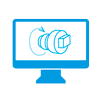The thrill of bringing an idea to life is what drives entrepreneurs, and really any business. Once you have a concept in mind, the next phase is to act on it. While acting on it is exhilarating, it also comes with inherent challenges as well as many, many questions.
We know that entrepreneurs have questions when it comes to building a prototype—so we sat down with our President and Chief 3D Officer, Collin Kobayashi, to discuss the prototyping process and get some expert advice on the subject.
(1) Question: What is your “rule of thumb” for entrepreneurs creating their first prototype?
 (1) C. Kobayashi: The application of the prototype may vary depending on its usage. Many times creating a conceptual prototype or something that conveys a proof of concept is the first step in leading towards a full product development plan. What is typically required is a minimum viable product (MVP) to demonstrate the functionality of the product. Because it is the very basic level of a prototype, it may not necessarily undergo a full industrial design, but rather a quick and simple design that demonstrates the capability and function.
(1) C. Kobayashi: The application of the prototype may vary depending on its usage. Many times creating a conceptual prototype or something that conveys a proof of concept is the first step in leading towards a full product development plan. What is typically required is a minimum viable product (MVP) to demonstrate the functionality of the product. Because it is the very basic level of a prototype, it may not necessarily undergo a full industrial design, but rather a quick and simple design that demonstrates the capability and function.
(2) Question: What is the number one issue you see entrepreneurs run into when developing a prototype?
(2) C. Kobayashi: The most typical issue is not developing a prototype that is manufacturable. Once they are past the “MVP” stage and ready to create a more robust design, they fail to account for DFM (Design For Manufacturing) principles which will cause major setbacks if not accounted for. The second issue that arises is that many entrepreneurs starting out don’t do enough testing or ask for customer feedback. This is a crucial step in the development process, which gets overlooked, because the entrepreneur feels that their approach is best.
(3) Question: Do entrepreneurs often come to you with an idea, and you build a prototype together, or a homemade prototype?
(3) C. Kobayashi: Ideas come in many shapes and forms, literally. Some entrepreneurs have built their own rough prototypes to try and convey their ideas while others only have sketches and renderings that depict what they want built. There are many ways to achieve what is required, but it is always best to discuss the details with your particular design company. Contact us here if you would like to discuss what types of options are available.
(4) Question: While 3D printing is a good tool for prototyping, are there any other tools that you recommend?
(4) C. Kobayashi: Parts can be made using many different methods such as 3D Printing, Molding, CNC machining, vacuum forming, etc. The process that is used will be based on the requirements of the customer and the applications in which the prototypes will be used. In some cases, parts need to be injection molded so that they can be used for compliance testing and pre-production use.
If you have additional questions, please head on over to our Frequently Asked Questions page or send us an e-mail at info@3d-innovations.com. We look forward to chatting!
_______
3D Innovations is a Product Development Company – from the 3D Design to a fully functional 3D Prototype & Product.
Startup Connector is a Manufacturing Accelerator helping companies commercialize—turning ideas into products.
Subscribe to the 3D Innovations newsletter on our Facebook page!

